Seller: Pricing Rules
How to use Pricing Rules in DOmedia
Pricing Rules can be set up in DOmedia to generate a suggested rate card for assets. There are two steps to the process.
- First, the rules need to be entered into the system.
- Second, proposals need to be set up to use and display pricing based on the rules.
Key Concepts
- This tool can be used for both markups and discounts
- More than one rule can apply to an asset within a proposal
- Base Rate need to be entered per asset at a flat rate or CPM for the calculations to work
- It is still up to the user to enter a net media cost in the proposal
Setting up Pricing Rules
Prerequisite 1: Set your company to use Pricing Rules
To instruct the system to use pricing rules on proposals, the company profile should be updated to fill information based on Asset Pricing Rules.
- In the Navigation bar click Account
- Click on Company Information
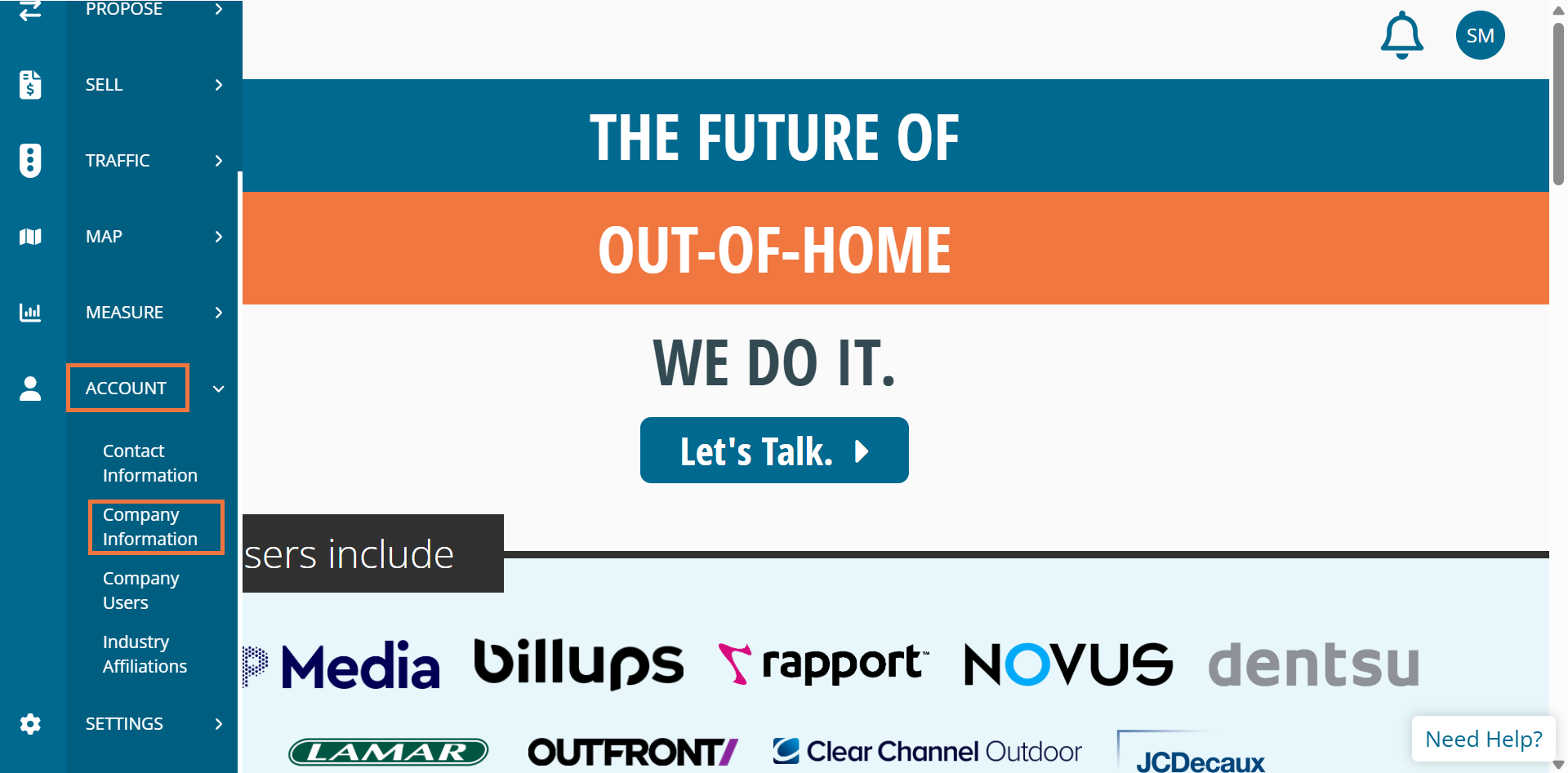
- In the Fill From Historical Options select Asset Pricing Rules. If you do not see this option please email oohsupport@domedia.com
- Click Save Changes
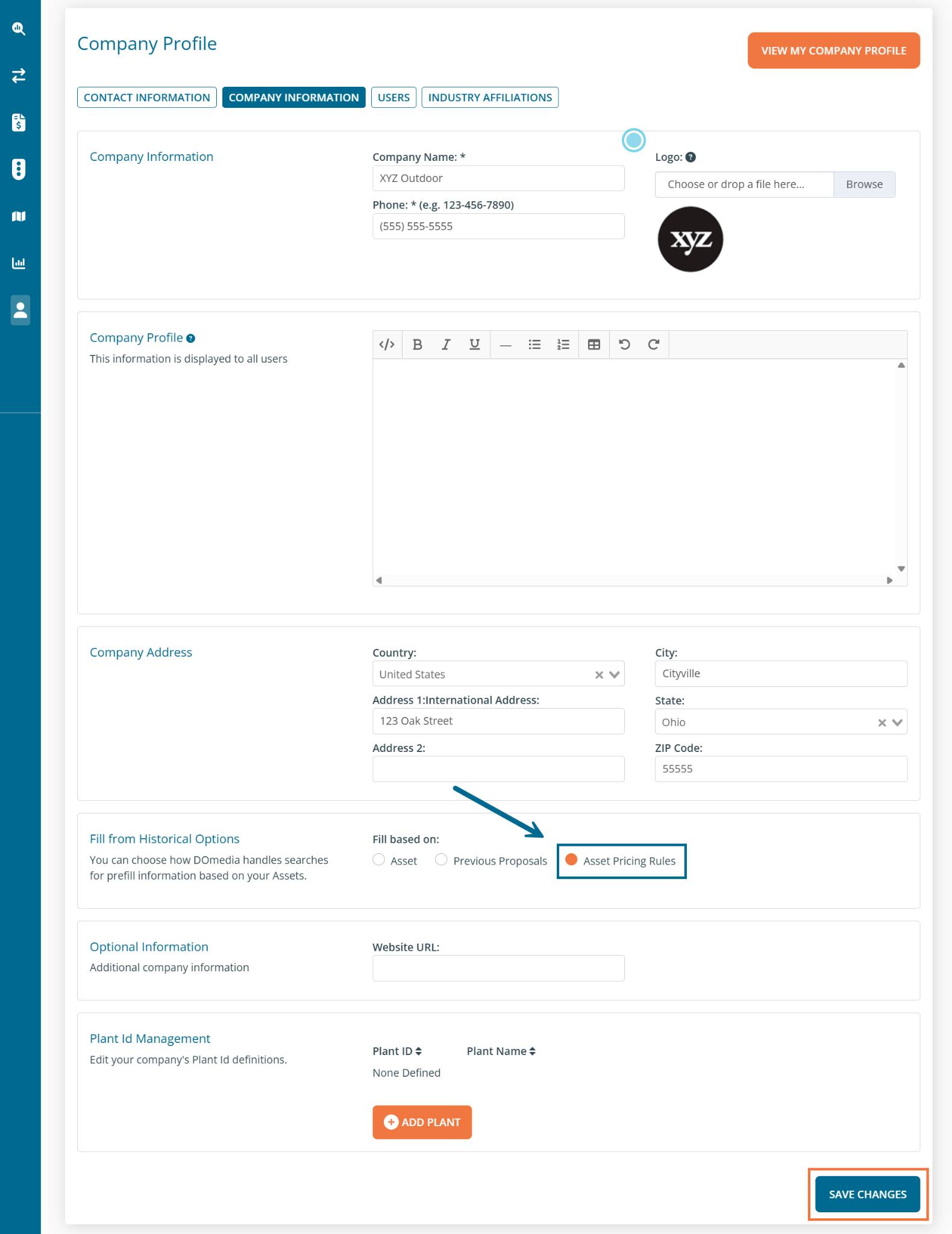
Prerequisite 2: Each asset must have a base rate card
Assets will need to have base rates in the system as a starting point. The pricing rules will be applied to the base rates to give suggested rate card rates. The base rate can be entered as a 4-week price and CPM. To enter a base Rate Card:
- In the Navigation bar, click Plan
- Click Search

- Select Criteria and click Search
- Find your desired asset and click Edit

- Click on the Pricing/Terms tab
- Click the checkbox beside 4-week and/or CPM
- Enter rates for 4-week and/or CPM
- Click Update Pricing
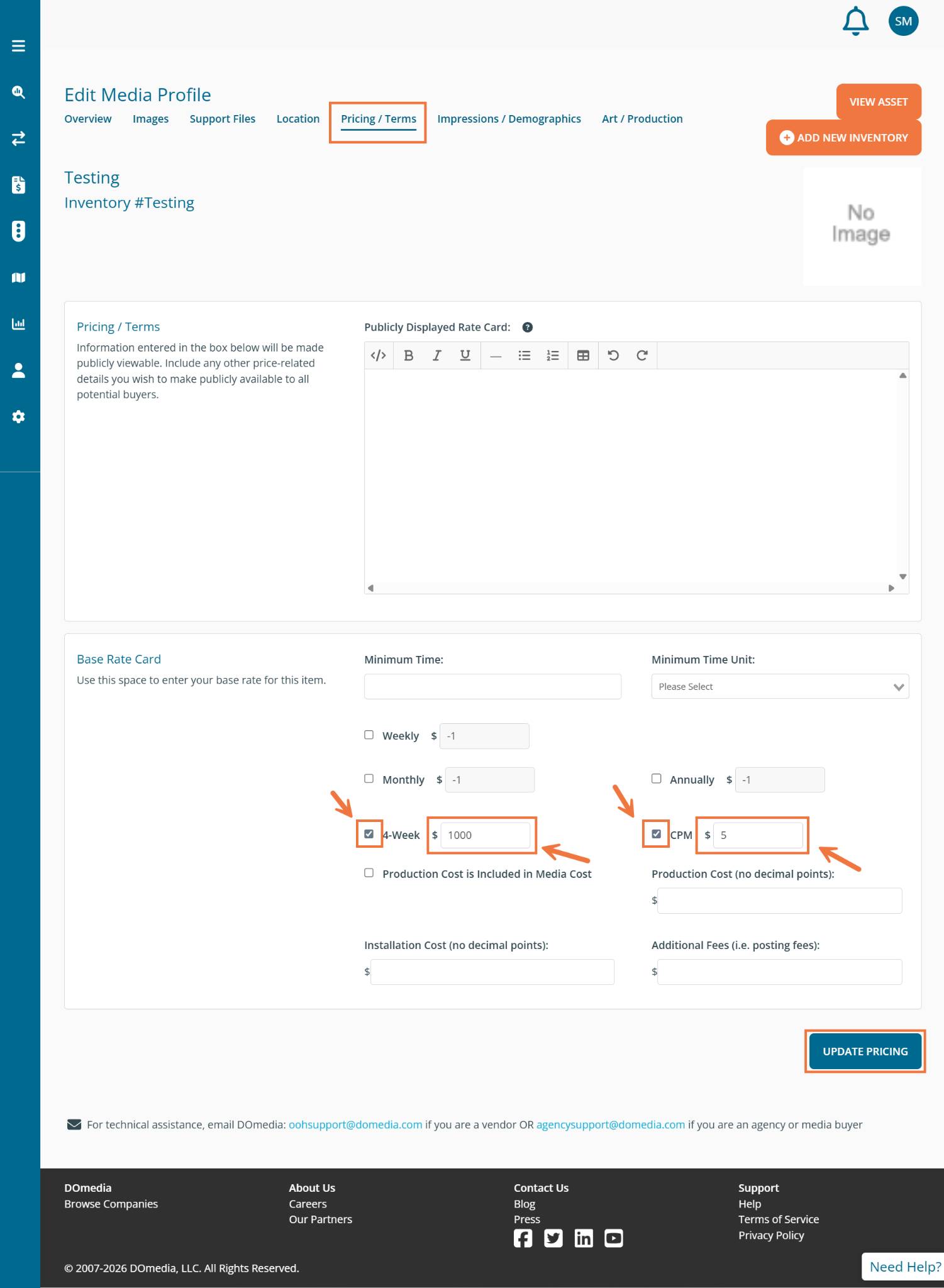
- Repeat for every asset that should have a pricing rule. If you want to apply base rates to many assets, email the rates (unique inventory number, type of rate and value) to oohsupport@domedia.com so we can bulk import your data.
DOmedia provides five ways to set up pricing rules for assets.
They include:
- Day Part
- Occupancy
- Seasonal
- Volume
- Client
1. Click Propose
2. Click Pricing
Here you will see a list of pricing rules setup for your company
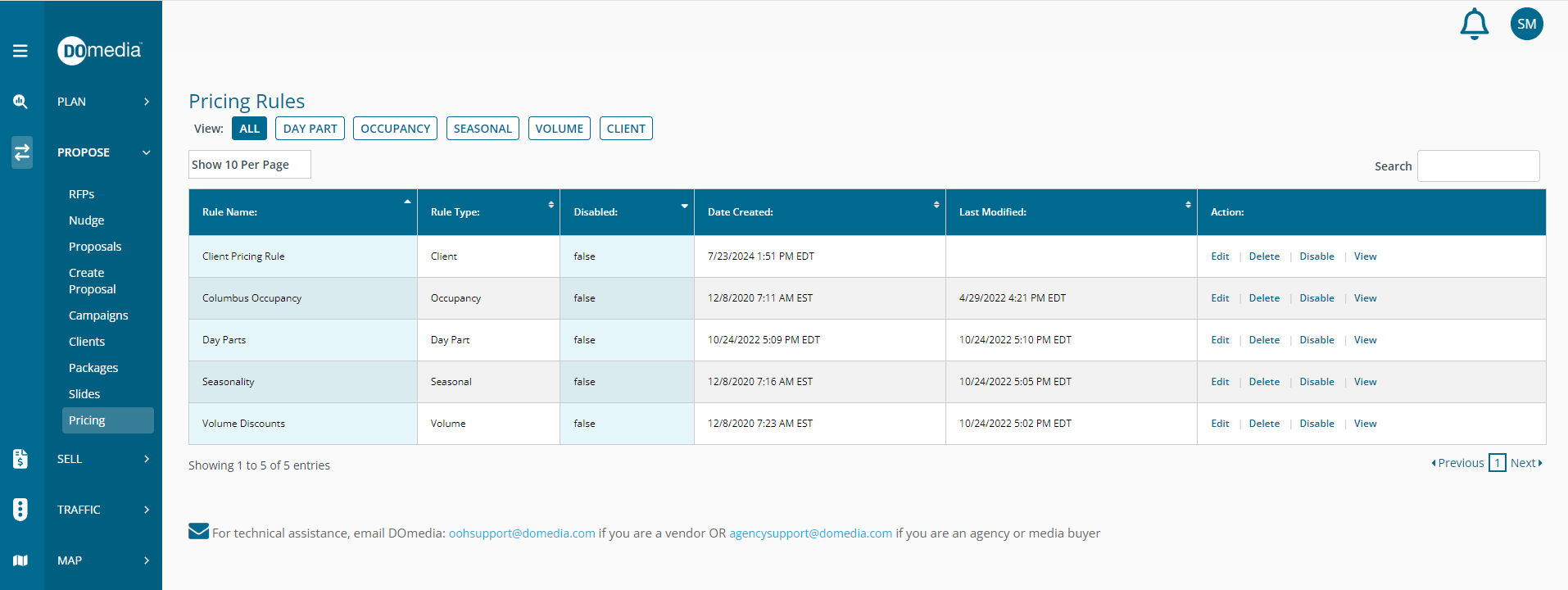
Please note that all pricing rules can be premiums or discounts. Discounts should always be indicated by a negative sign (-).
Day Part Pricing Rules
These can be created for every hour of the day repeating each week. The pricing can be altered by a percent or dollar amount applied to the base rate. Day Part rules can be applied to all digital assets, specific formats, specific assets, or packages. Day Part Pricing Example: Give a discount at night and get a premium on morning rush hour. In the example below, the rule will apply a 15% discount to media proposed during overnight hours and a 10% premium to media proposed during morning rush hours
- From the Pricing Rules list, click Day Part
- Click Create Pricing Rule

- Give the rule a name. This name of the rule displays in the proposal grid. Therefore, a rule name that makes sense for your whole company is suggested
- Set the Type of Discount to a Percent
- Leave Face Assignment set to all Assets
- Click Create Pricing Rule
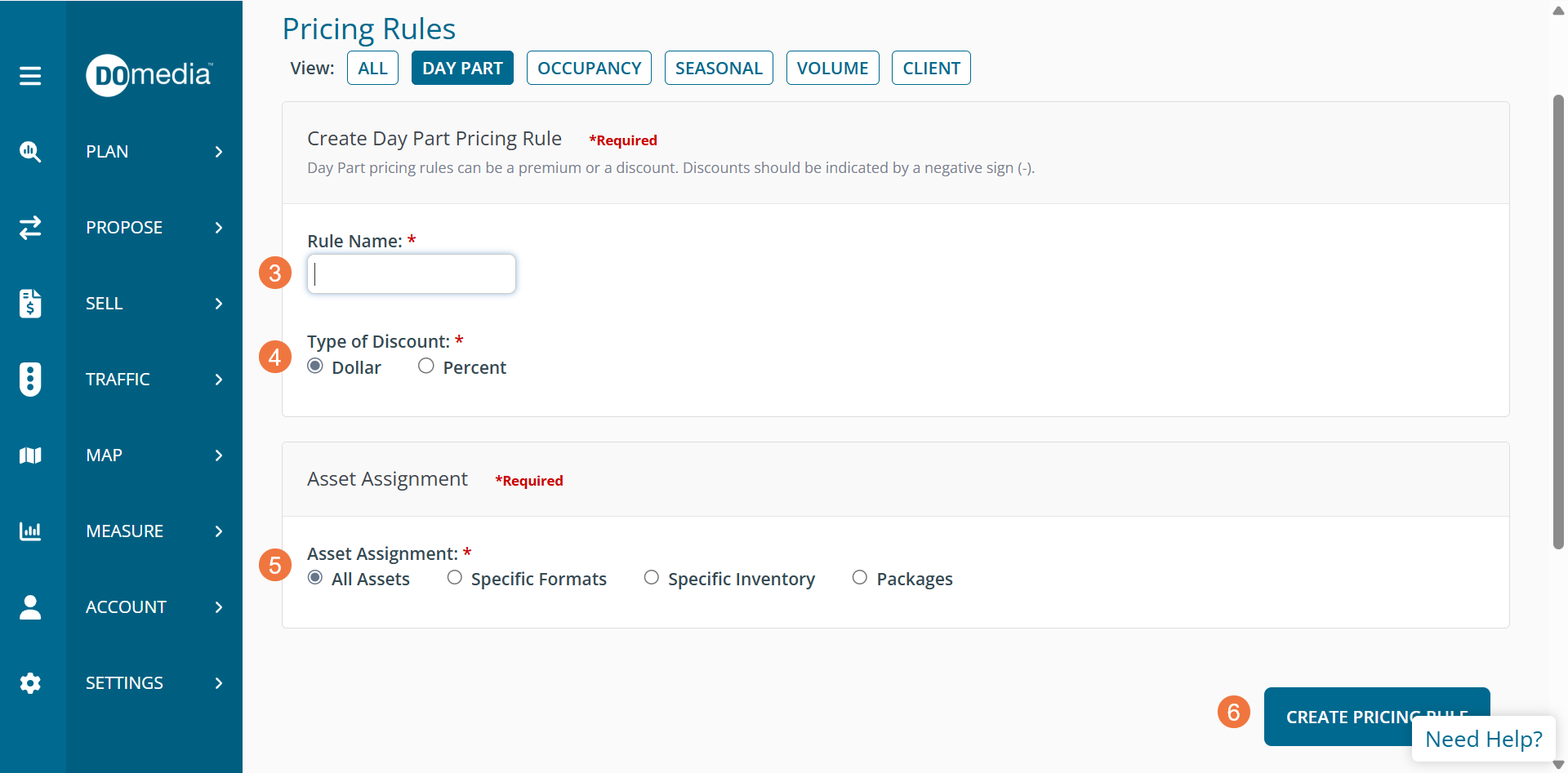
- In the pricing rule grid set the discounts and premiums based on time of day and day of week.
- Enter minus 15 for everyday 1am to 4:59am
- Enter positive 10 for Monday through Friday 5am to 7:59am
- To add additional day part pricing rules, enter a value into the desired fields.

- Click Save
All future Proposals that include assets where this Day Part rule is applicable will be displayed
Occupancy Pricing Rules
These are based on occupancy in a market or markets. The pricing can be altered by a percentage applied to the base rate. Occupancy rules can be applied to all assets or specific formats.
The Occupancy Rate = [(# of units sold/contracted) + (current proposal of the specified format(s) in the specified market(s)] / [# of units of the specified format(s) in the specified market(s) that exist in DOmedia]
Occupancy Pricing Example: Get a Premium in Markets that are selling out
- From the Pricing Rules list click the Occupancy tab
- Click Create Rule

- Give the rule a name. This name of the rule displays in the proposal grid. Therefore, a rule name that makes sense for your whole company is suggested
- In Face Assignment, leave all assets selected
- Select one or more markets
- Click Create Pricing Rule

- In the pricing rule grid, enter ranges of occupancy and their corresponding premium
- Enter 0% when occupancy is 0 to 90% because there is no premium yet.
- Enter 10% when the occupancy is 90 to 97%
- Enter 25% when the occupancy is 98% or higher
- To add another occupancy threshold, use the plus sign.
- Click Save
- All future proposals that include assets where this Occupancy Rule is applicable will be displayed
Seasonal Pricing Rules
These are based on dates. The pricing can be altered by a percent or dollar amount applied to the base rate. Seasonal rules can be applied to all assets, specific formats, specific assets, or packages.
Seasonal Pricing Example: Markup Posters at the end of the year
- In the example below, the rule will apply a percent change to Horizontal Posters during the date ranges entered. Date ranges are entered as month/day - month/day. The example shows a premium in the month of December and a discount in January.
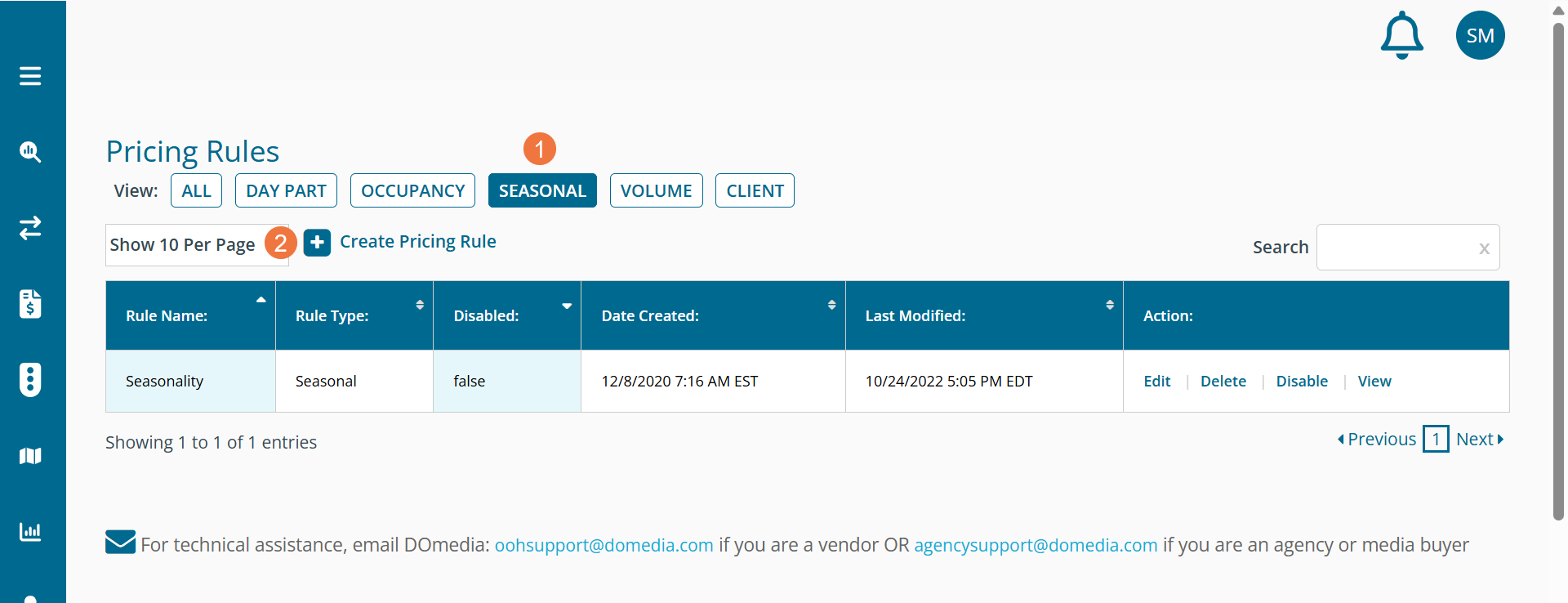
- From the Pricing Rules list, click Seasonal tab
- Click Create Rule
- Give the rule a name. This name of the rule displays in the proposal grid. Therefore, a rule name that makes sense for your whole company is suggested
- Select Percent
- Select Specific Formats
- Select Billboards - Posters
- Click Create Pricing Rule

- In the pricing rules grid, enter markups and discounts during date ranges
- For example, enter 12/1 - 12/31 at a 10% markup, 1/1 to 1/31 with 15% discounts and 2/1 to 3/14 with a 10% discount
- To add rules, click the plus sign

- Click Save
- All future proposals that include assets where this Seasonal Rule is applicable will be displayed
PRO TIP - You will only see this rule once you include dates in your proposal.
Volume Pricing Rules
These can be based on the volume of units/impressions or time. The pricing can be altered by a percent or dollar amount applied to the base rate. Volume rules can be applied to all assets or specific formats.
Volume Pricing Example: Discount for different # of Units. This is also known as price breaks.
- In the example below, the Volume Rule will apply an amount discount based on the number of units proposed for one cycle. Proposing eight units would result in a $20 discount.
- From the Pricing Rules list, click Volume tab
- Click Create Rule

- Give the rule a name. This name of the rule displays in the proposal grid. Therefore, a rule name that makes sense for your whole company is suggested
- Select $ off Total
- Select # of Units
- Select All Assets
- Click Create Pricing Rule
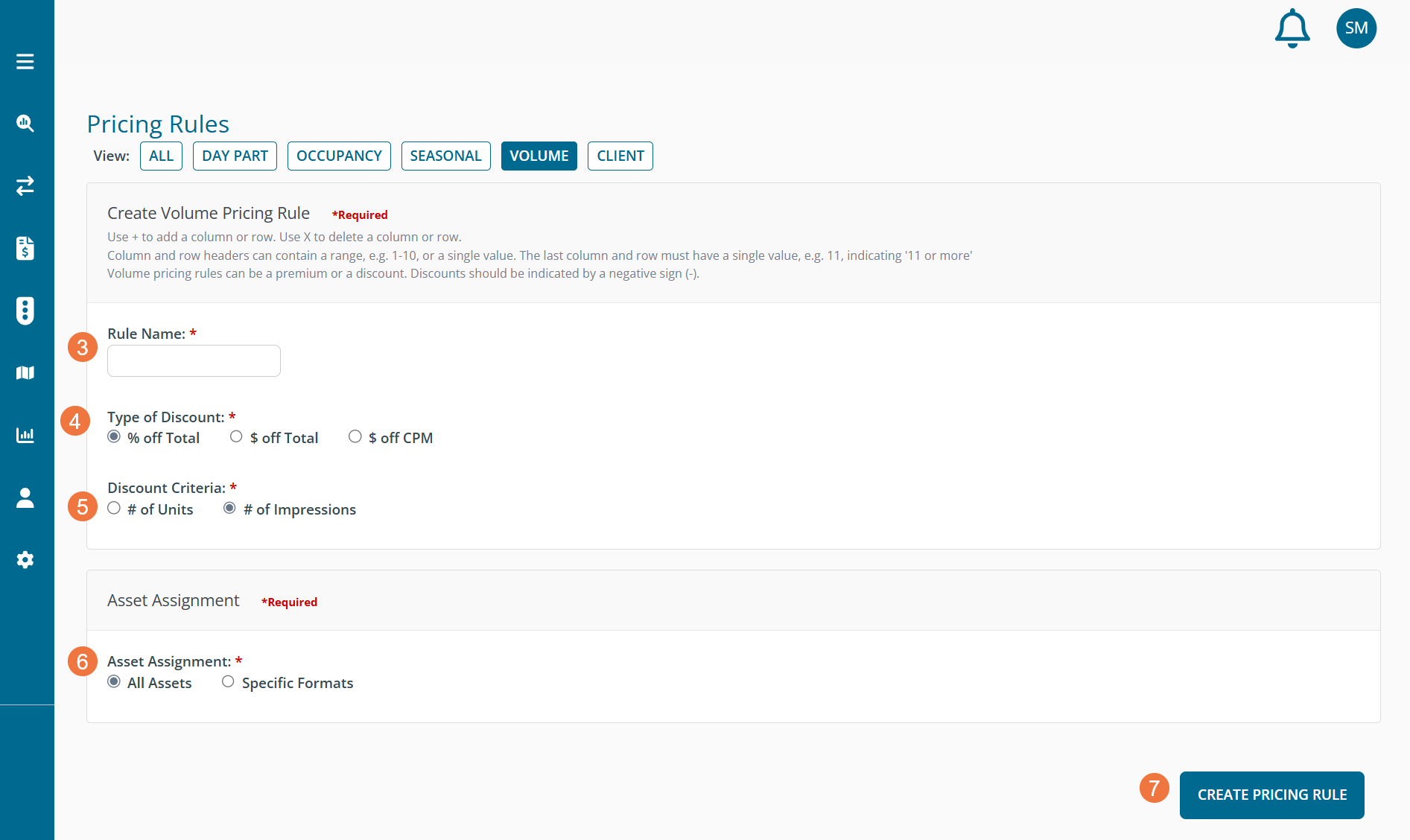
- In the pricing rule grid enter the discounts (include negative signs) for the different ranges of units.
- Enter a range for the # of Units on which to apply the discount.
- For example, enter 0-5 units at $10 off, 6 to 10 units at $20 off, 11 to 13 units at $25 off and 14 units at $50 off:
- The last column must be a single number meaning that number or any number of units greater than that number. In this example, a discount of $50 would be added if 14 or more units are proposed.
- To add another discount threshold, use the plus button.
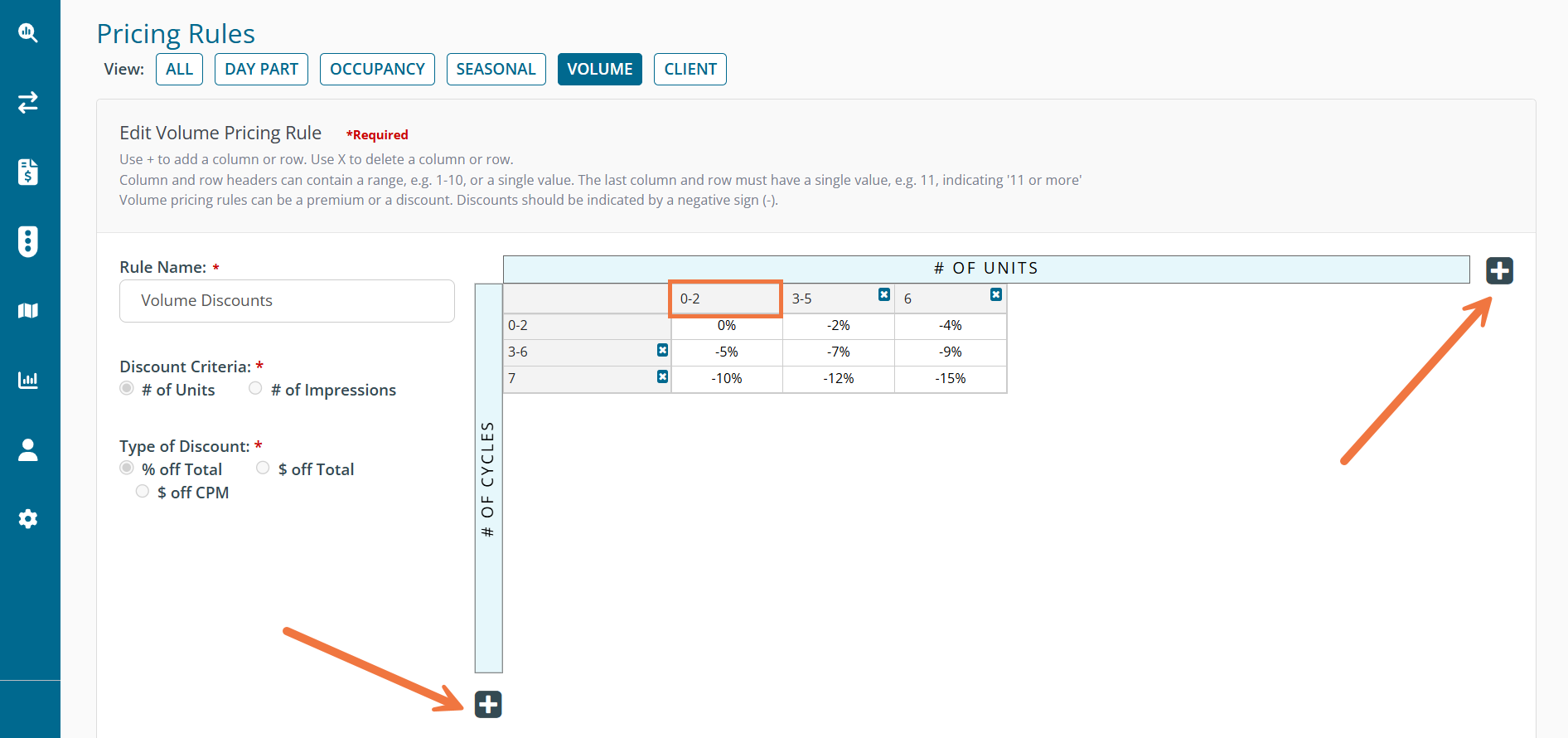
- Click Save
- All future proposals that include assets where this Volume Rule is applicable will be displayed
Client Pricing Rules
These can be created for specific customers, so that anytime you create a proposal for that client the discount will be applied to the rate card. The pricing can be altered by a percent applied to the base rate. Client pricing rules can be applied to all assets, specific formats, all markets, or specific markets.
Client Pricing Example: Give a discount to the client XYZ Media for bulletins and digital bulletins in the Columbus, OH and New York City, NY markets.
- From the Pricing Rules list, click Client
- Click Create Pricing Rule

- Give the rule a name. This name of the rule displays in the proposal grid. Therefore, a rule name that makes sense for your whole company is suggested
- Set the discount percentage
- Select the Client XYZ Media
- Select Specific Formats, and double click on Billboards - Bulletins and Billboards - Digital Bulletins
- Select Specific Markets, and double click on Columbus, OH and New York City, NY
- Click Create Pricing Rule
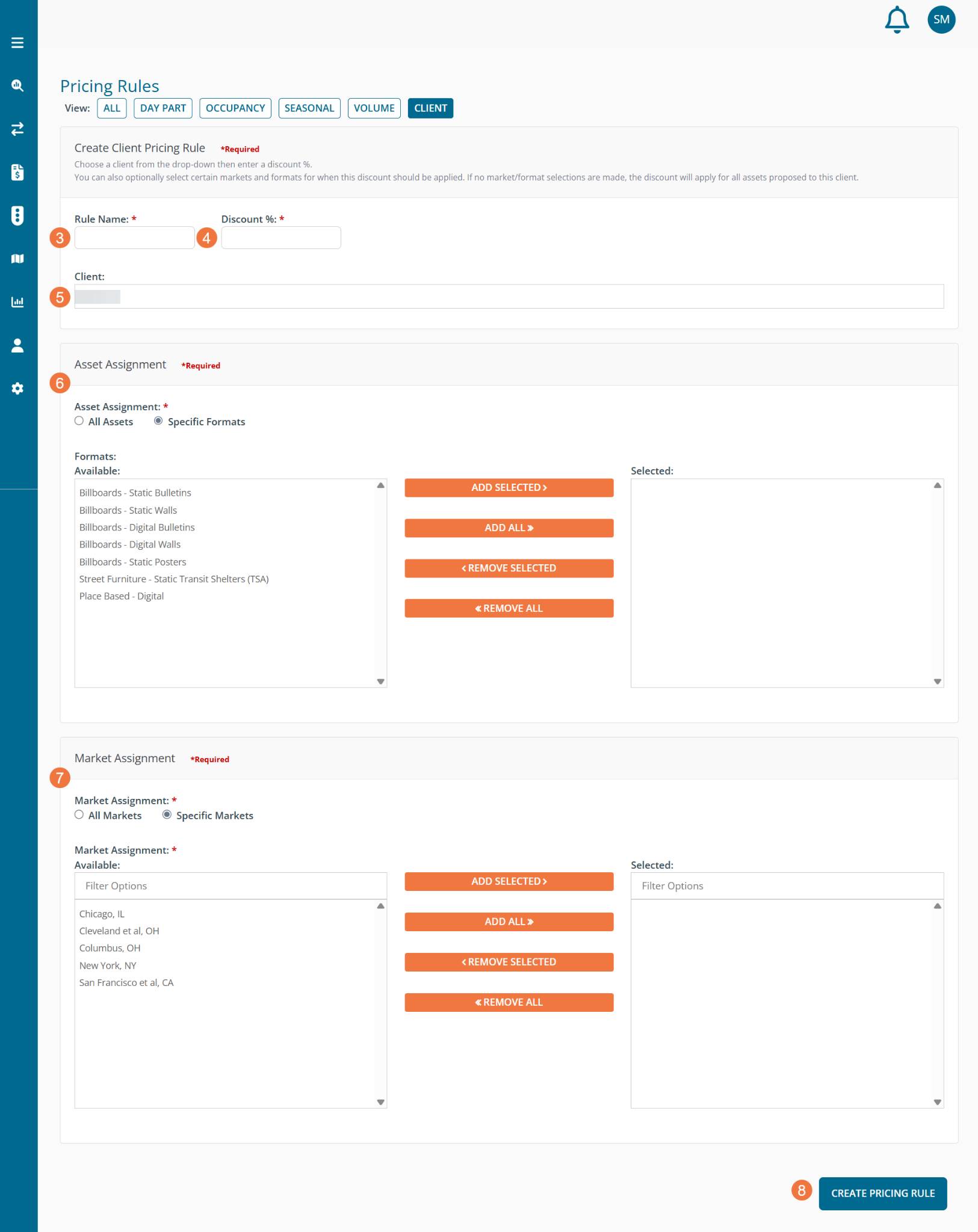
Using Pricing Rules
Set Up Proposal Templates for Pricing Rules
To utilize pricing rules on a proposal you will want to set up a proposal template that includes pricing headers.
- Click Settings
- Click Templates
- Click Create for a new template or Edit to update an existing template
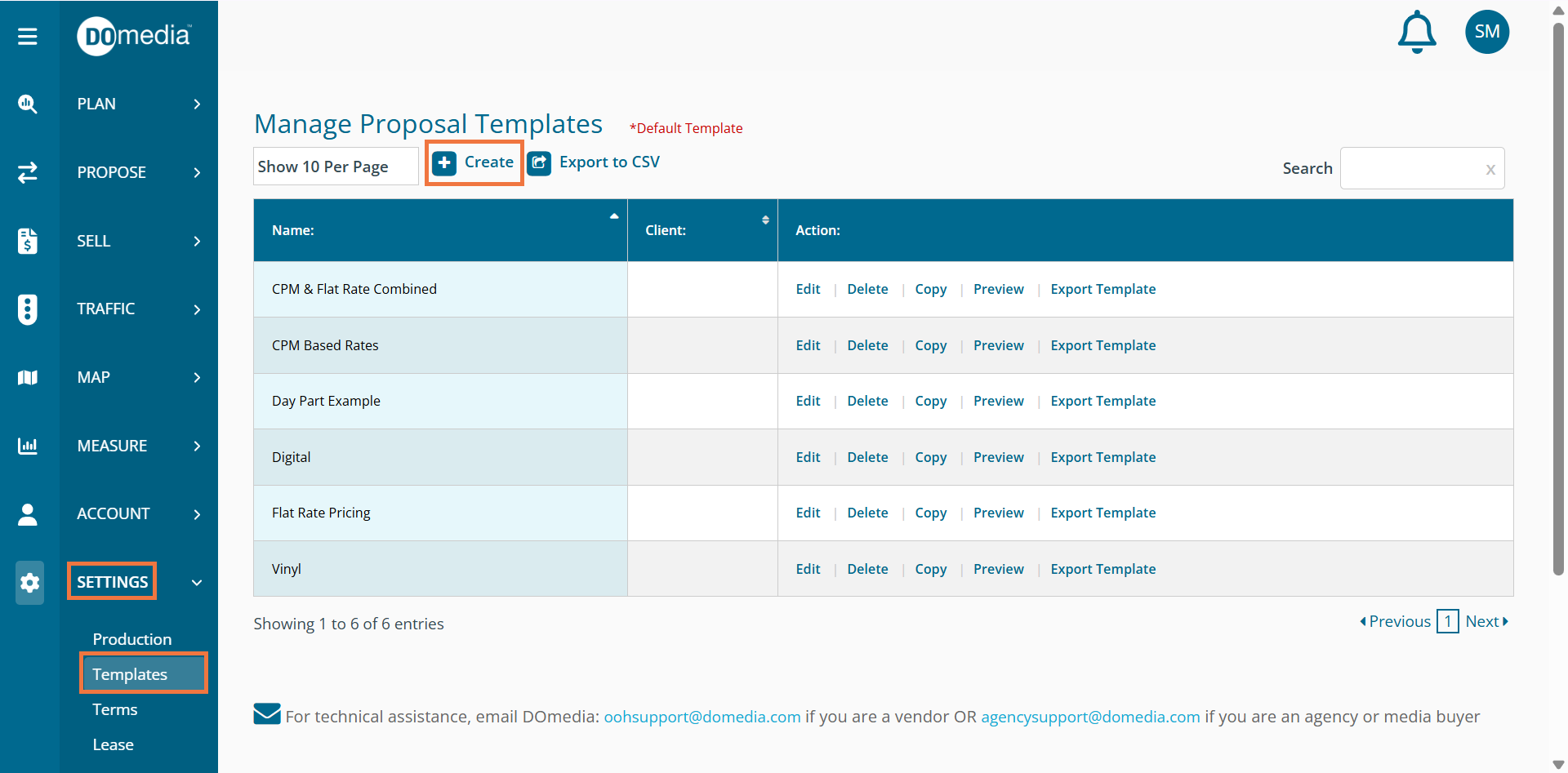
There are five proposal columns that relate to Pricing Rules:
- Rate Card CPM - the base cost entered in the CPM field in the asset
- Rate Card CPM Details - a list of all the rules that apply to the asset and the resulting suggest cost
- Rate Card Cost / Cycle - the base cost entered in in the 4-week field in the asset
- Rate Card Details - a list of all the rules that apply to the asset and the resulting cost
- CPM-based Calculations - Choose between CPM or Base Rate.
- If you include both CPM and Flat Rate pricing in your template, you have to tell the system which one to use per row in your proposal.
- The system defaults to Flat Rate Pricing. That means CPM-based calculation will be set to No (N)
- When CPM-Based Calculations is set to No (N), the list of pricing rules applied is spelled out in the Rate Card Details filed.
- When CPM-Based Calculations is set to Yes (Y), the list of pricing rules applied is spelled out in the Rate Card CPM Details field.
Option A: CPM pricing
Reminder: To use this, you must have entered a CPM when setting up your inventory:

- In your proposal template check to confirm both Rate Card CPM and Rate Card CPM Details are in your template columns. If they're not, click the left arrow on those fields to ensure they're in your template. PRO TIP - placing the Net Media Cost / Cycle field directly after these fields makes generating a proposal easier.

- Click Save if necessary.
Rules for how CPM is calculated:
The system looks and which asset fields have values and which columns are in a proposal template to determine which formula is used to calculate CPM.
1. If both 4-week Base Rate and CPM Base Rate values are empty: $0
This means there is not enough information to calculate a CPM.
2. If 4-week Base Rate >0 and CPM Base Rate is empty: Rate Card/Cycle / (18+ Impressions/Cycle / 1000)
This means the 4-week Base Rate will be pulled from the asset and that the impressions will be pulled from the Weekly Impressions field on the asset to calculate Base CPM in the proposal.
3. If CPM Base Rate >0 and 4-week Base Rate is empty: Base Rate CPM * ( % pricing rules for asset) + (dollar based pricing rules for asset)
This means the rate will pull directly from the CPM base rate field from the asset and then if there are pricing rules apply rules that use percentages then rules that are dollar based.
4. If both 4-week Base Rate and CPM Base Rate are > 0, and any of these three columns are not present: CPM Based Calculation, Rate Card CPM, Net CPM, use rule 2 above
This means the 4-week Base Rate will be pulled from the asset and that the impressions will be pulled from the Weekly Impressions field on the asset to calculate Base CPM in the proposal.
5. If both 4-week Base Rate and CPM Base Rate are > 0, and user has included the Rate Card CPM, Net CPM, and CPM Based Calculation columns, check the value in the CPM Based Calculation column: If Yes, use Rule 3 above If No, use Rule 2 above
Option B: Flat Rate Pricing
Reminder: To use this, you must have entered a 4-week price when setting up your inventory:
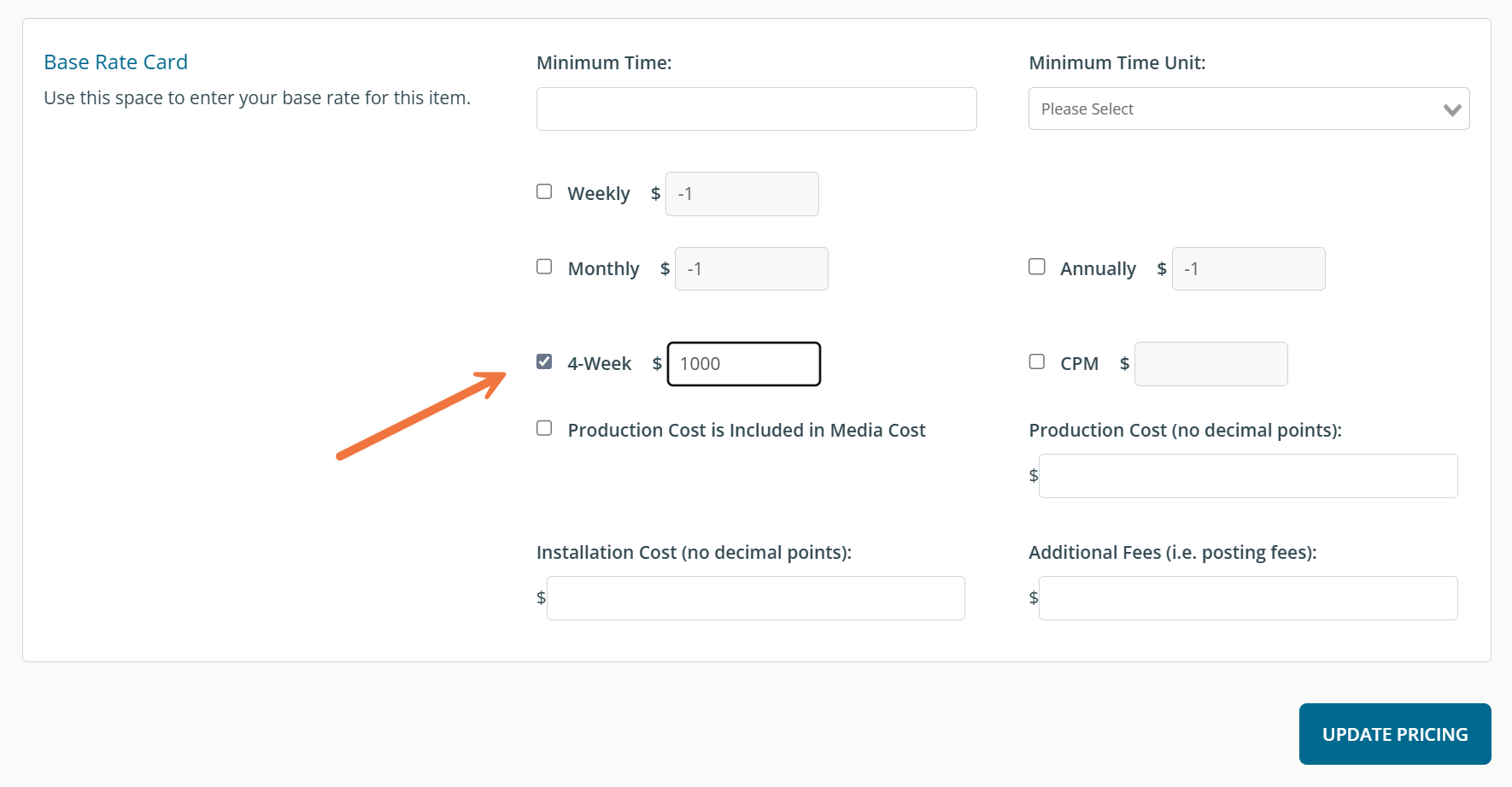
- In your proposal template check to confirm both Rate Card Cost / Cycle and Rate Card Details are in your template columns. If they're not, click the left arrows on those fields to ensure they're in your template. PRO TIP - placing the Net Media Cost / Cycle field directly after these fields makes generating a proposal easier.
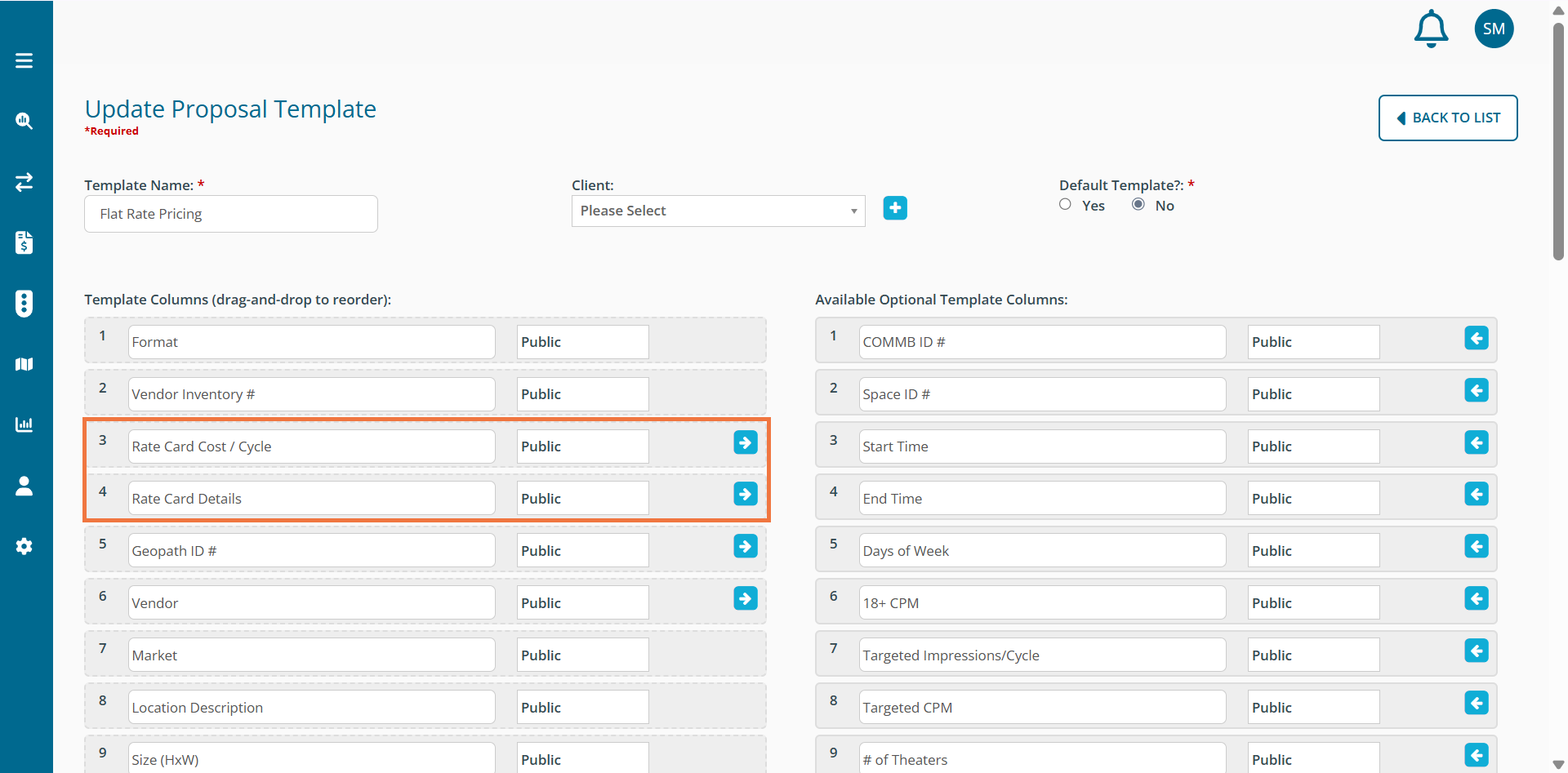
- Click Save if necessary.
Option C: Both CPM & Flat Rate Pricing combined
Reminder: To use this, you must have entered a CPM and a 4 week price when setting up your inventory:
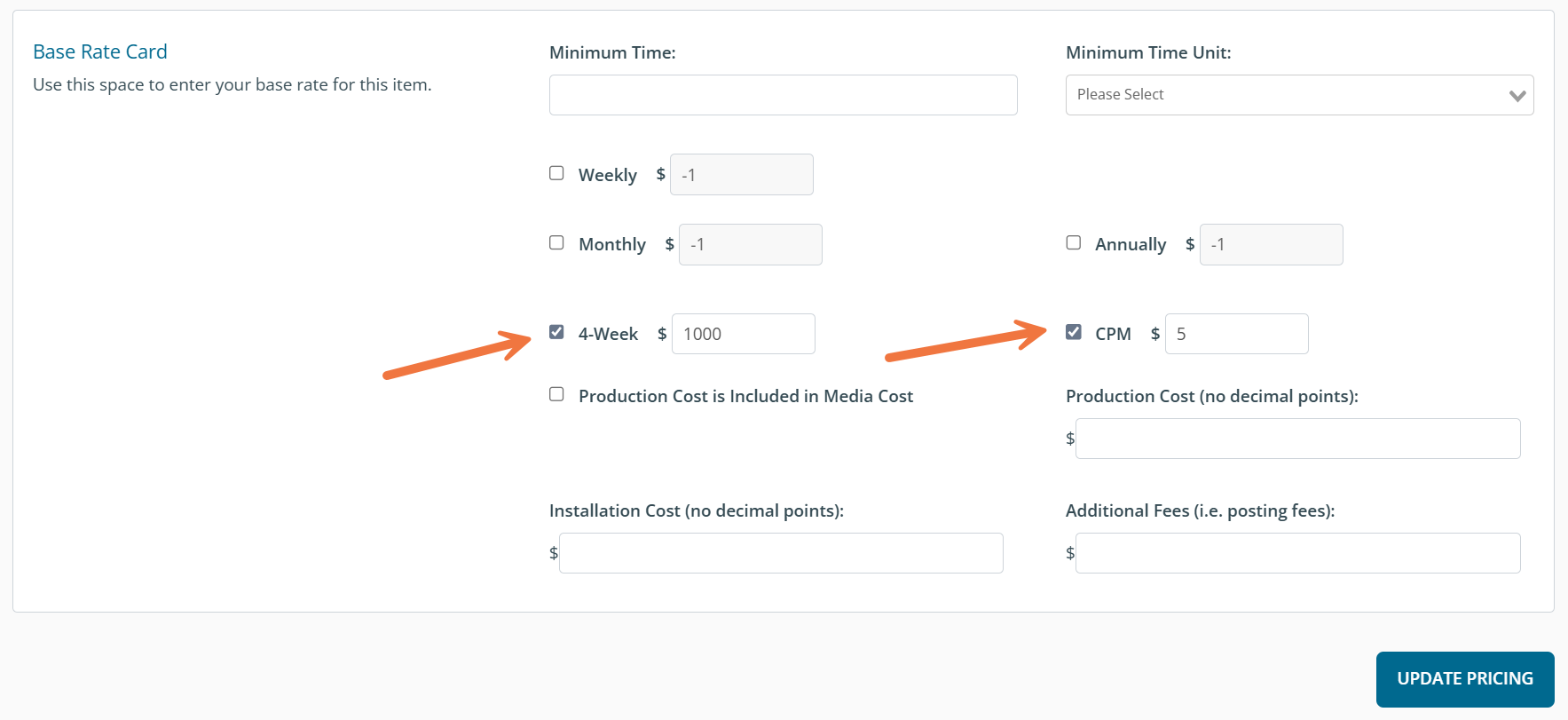
- In your proposal template check to confirm Rate Card Cost / Cycle, Rate Card Details, Rate Card CPM, Rate Card CPM Details, and CPM-Based Calculations are in your template columns. If they're not, click the left arrows on those fields to ensure they're in your template. PRO TIP - placing the Net Media Cost / Cycle field directly after these fields makes generating a proposal easier.
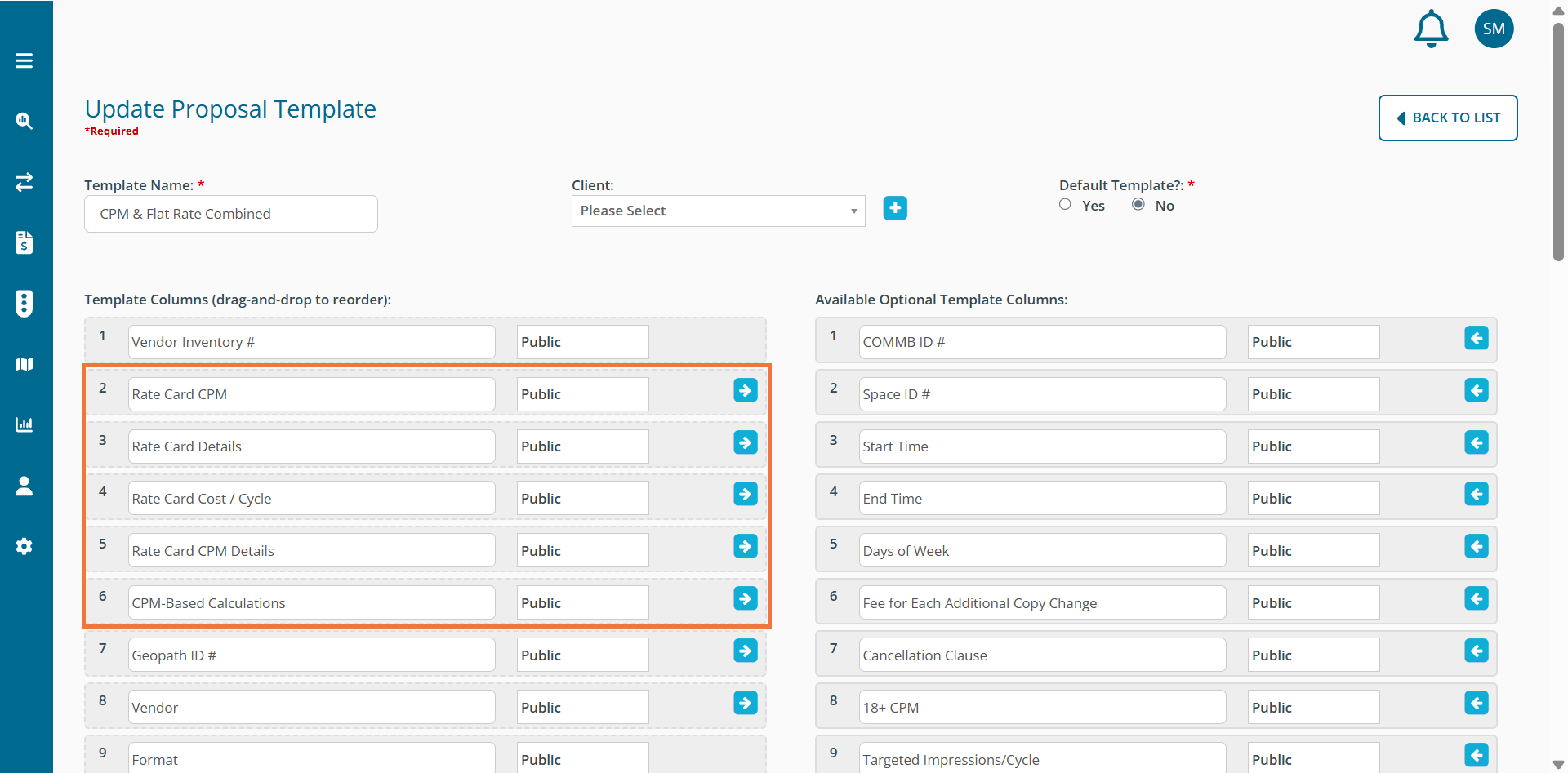
- Click Save
Create Proposals Using Templates with Pricing Rules
- Click Propose
- Click Create Proposal
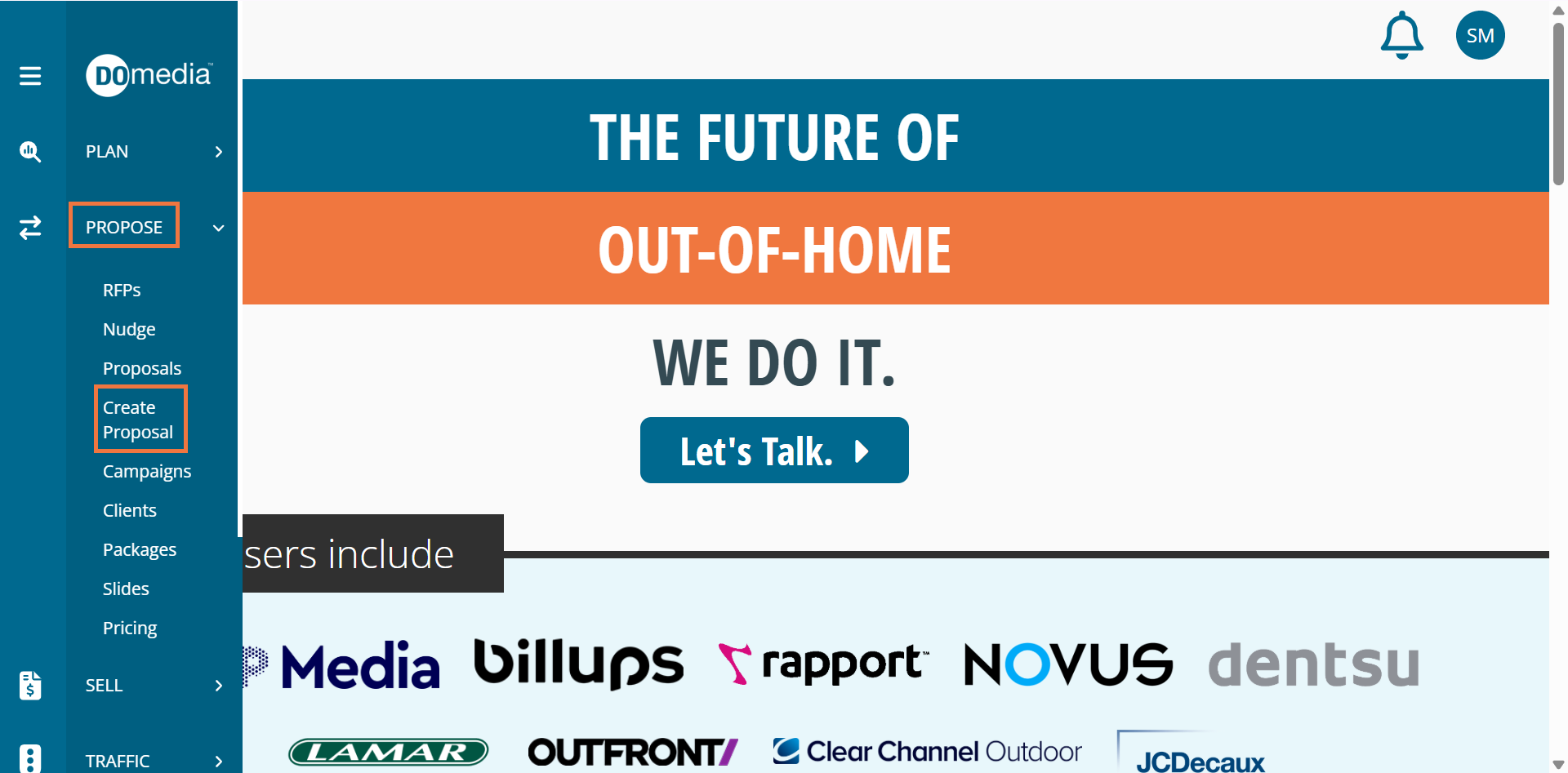
- On Step 1, select your template that has pricing columns
- Fill out the rest of Step 1 as usual
- Click Next
Pricing Rules Applied in Proposal Step 2
- If you choose a template with pricing headers and have pricing rules set up, you will see suggested rates and information in the proposal grid. The rate and detail information is read-only and can not be changed. They are provided as a service.
- * The Rate Card/Cycle value is not updated based on pricing rules or the inclusion of the pricing headers.
Option A: CPM pricing
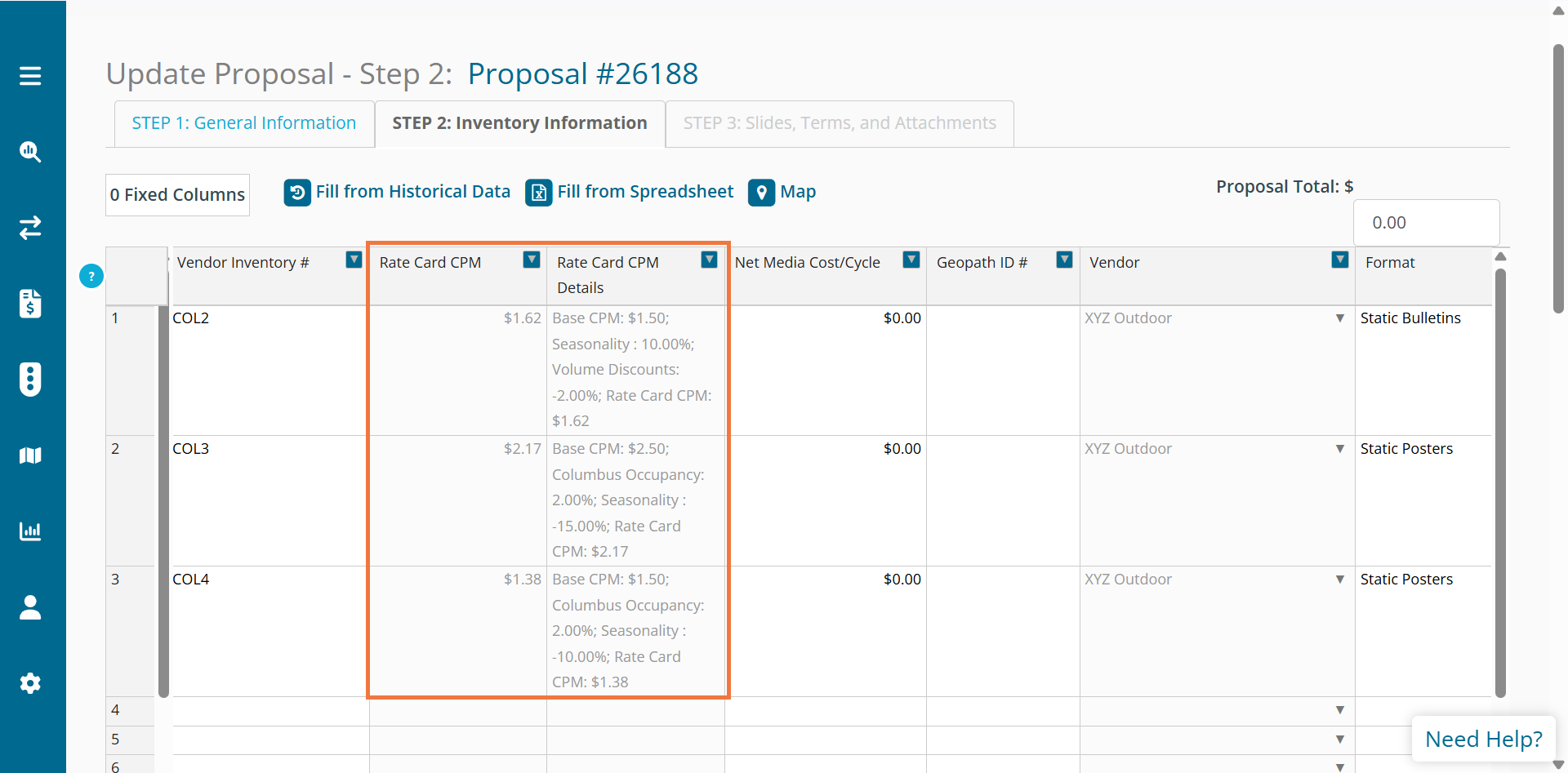
- The Rate Card CPM column will show the suggested CPM price for the media.
- The Rate Card CPM Details column will show you the Base CPM value, any pricing rules that were applied to the value, and the suggested CPM Price.
- The user still enters the Net Media Cost / Cycle
In this example, the media in the first row has a base CPM of $1.50. A seasonal 10% upcharge, as well as a volume discount of 2% is applied to the price for a suggested CPM price of $1.62. The second row has a base CPM of $2.50, with a 15% seasonality discount, as well as a 2% Columbus Occupancy upcharge applied. The result is a suggested rate of $2.17. The third row has a base CPM of $1.50, with a 10% seasonality discount, as well as the same 2% Columbus Occupancy upcharge applied, for a suggested rate of $1.38.
Option B: Flat Rate pricing
- The Rate Card Cost/Cycle column will show the suggested price for the media.
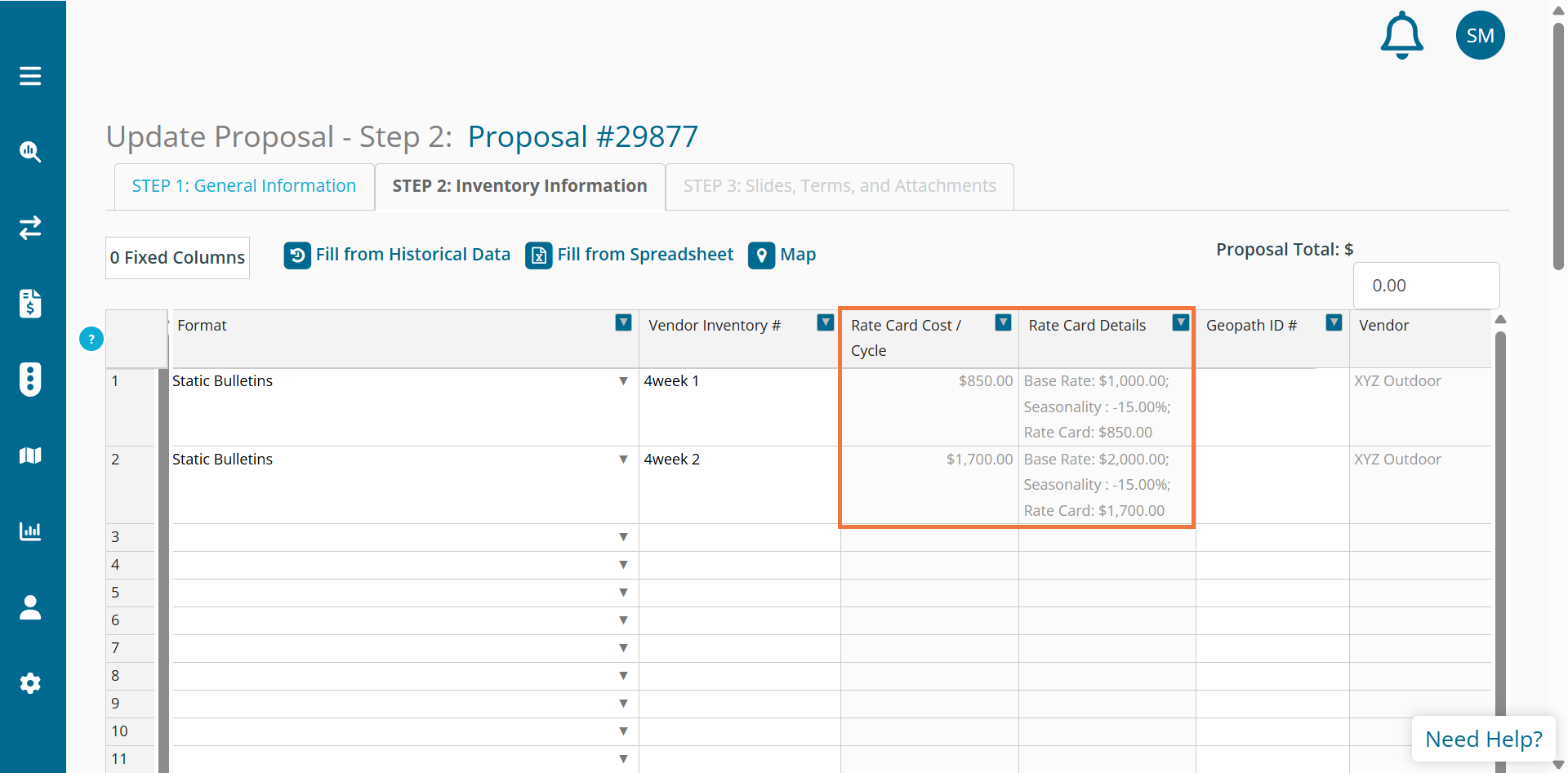
- The Rate Card Details column will show the the base 4 week rate, any pricing rules that were applied to the value, and the suggested rate.
- The user still enters the Net Media Cost / Cycle
In this example, the media in the first row has a base rate of $1,000. A seasonal 15% discount is applied to the price for a suggested price of $850. The second row had a base rate of $2,000 and the same rules applied. The result is a suggested rate of $1,700.
Option C: Both CPM & Flat Rate Pricing combined

- If you include both CPM and Flat Rate pricing in your template, you have to tell the system which one to use per row in your proposal.
- To be able to toggle between CPM or Flat Rate Pricing, adjust the CPM-based calculations column from Yes (Y) to No (N).
- The system defaults to Flat Rate Pricing. That means CPM-based calculation will be set to No (N)
- In this example, in the first and second rows, you can see that when CPM-Based Calculations is set to No (N), therefore the list of pricing rules applied is spelled out in the Rate Card Details filed.
- In the third and fourth rows, CPM-Based Calculations is set to Yes (Y). Therefore the list of pricing rules applied is spelled out in the Rate Card CPM Details field.
FAQs
Q: Why isn’t my pricing rule working in my proposal?
A: You must have pricing rules enabled at the company level.
- You must have at least one asset with a base rate card and impressions.
- You must have a pricing rule that applies to that asset. (Remember to fill out columns such as # of Cycles to trigger the pricing rule).
- You must use a proposal template that includes pricing rules columns.
- You must include the asset that applies to pricing rules in the proposal.
Q: If I change the base rate card for an asset that’s already in a proposal, what happens?
A: The next time you click save on the proposal, the system re-checks the base rate card and will reflect the new base rate in the proposal grid
